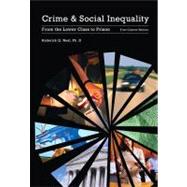Preface: viii
Appreciations: x
Organization: xii
Chapter 1. Explanations of Crime and Deviance ................................................................1
• Schools, Thought & Theoretical Perspectives ......................................2
• Introduction ..........................................................................................3
• Traditional Explanations for Crime ......................................................3
• Spiritual Explanations for Crime ..........................................................3
• Natural Explanations ............................................................................4
• Natural Explanations for Crime ............................................................4
• Classical School....................................................................................5
• Neoclassical School ..............................................................................5
• Cartography ..........................................................................................6
• Positivist School....................................................................................6
• Cesare Lombroso ..................................................................................7
• Biological/Biosocial Theories ..............................................................7
• Drugs and Crime ..................................................................................9
• Psychological Factors ..........................................................................10
• Differential Association ........................................................................11
• Chicago School ....................................................................................12
• Shaw McKay ........................................................................................12
• Strain Theory ........................................................................................12
• Conflict Theory ....................................................................................13
• Labeling Theory....................................................................................14
• Control Theories ..................................................................................14
• Control Theory: Elements of Social Bond............................................15
• Travis Hirschi on Control Theory ........................................................15
• A General Theory of Crime: Gottfredson and
Hirshci ..............................................................................................16
• Developmental Factors ........................................................................16
• Social Disorganization as It Relates to Social
Capital ..............................................................................................17
• Integrated Theories: Some Considerations and a
Proposed Model................................................................................18
• Elliot’s Integrated Theory of Delinquency and
Drug Use ..........................................................................................19
• Criminal Behavior and Public Policy: Future
Directions..........................................................................................19
Chapter 2. Explanations of Social Inequality ......................................................................21
• Social Inequality Diagram ....................................................................22
• Explanations of Inequality ....................................................................23
• Classes and Masses ..............................................................................23
• Classical Views of Social Inequality ....................................................23
• Max Weber............................................................................................25
• Durkheim ..............................................................................................26
• Mechanical Solidarity ..........................................................................27
• Organic Solidarity ................................................................................28
• Social Structure ....................................................................................28
• Cause of Organic Solidarity..................................................................28
• Division of Labor..................................................................................28
• Davis and Moore ..................................................................................29
• Power Elite............................................................................................30
• Dahrendorf’s Conflict Theory ..............................................................31
• Giddens ................................................................................................32
• Domhoff ................................................................................................32
• Wright’s Marxian View ........................................................................33
• William Julius Wilson: Truly Disadvantaged and When
Work Disappears ..............................................................................34
• Massey and Denton (American Apartheid)
The Making of the Underclass..........................................................36
• Culture of Poverty ................................................................................36
• Global Inequality ..................................................................................39
• Gender Inequality ................................................................................40
• Social Class ..........................................................................................41
• Social Inequality and Culture ..............................................................43
• Inequality Research ..............................................................................44
• The Inequality of Educational Attainment............................................45
• Contemporary Views ............................................................................46
• Poverty in America ..............................................................................47
• Personal Reflection ..............................................................................49
• Conclusion ............................................................................................49
Chapter 3. Crime and Social Inequality ..............................................................................51
• Crime and Social Inequality Diagram ..................................................52
• Introduction ..........................................................................................53
• Social Disorganization/ Crime Ecology................................................54
• Broken Window Theory........................................................................56
• Merton’s Strain Theory ........................................................................56
• Social Capital ........................................................................................57
• Culture ..................................................................................................58
• Consequences of Criminal Behavior ....................................................59
• Recidivism ............................................................................................60
• Drug Crime Relationship ......................................................................62
• Intervention/ Drug Courts ....................................................................63
• Social Class and Crime ........................................................................64
• Conclusion ............................................................................................65
Chapter 4. Juvenile Delinquency Research ........................................................................67
• Chapter Four Summary ........................................................................68
• Identifying At Risk Youth ....................................................................68
• Literature Review..................................................................................70
Social Predictors ............................................................................72
Psychological Predictors................................................................74
Other Predictors ............................................................................75
Method ..........................................................................................79
Subjects..........................................................................................79
Procedure ......................................................................................80
Results ..........................................................................................80
Discussion......................................................................................81
Summary and Conclusions ............................................................81
Limitations of the Study ................................................................82
Appendix A ............................................................................................83
Appendix B ............................................................................................85
Appendix C ............................................................................................87
Chapter 5. Drug Crime Relationship ..................................................................................89
• Chapter Five Summary ........................................................................90
• Overview ..............................................................................................90
• Statement of the Problem......................................................................92
• Literature Review..................................................................................92
• Methodology ........................................................................................109
• Findings ................................................................................................113
• Discussion/Conclusions ........................................................................141
References: ..........................................................................................................................147
Word Glossary: ....................................................................................................................161








